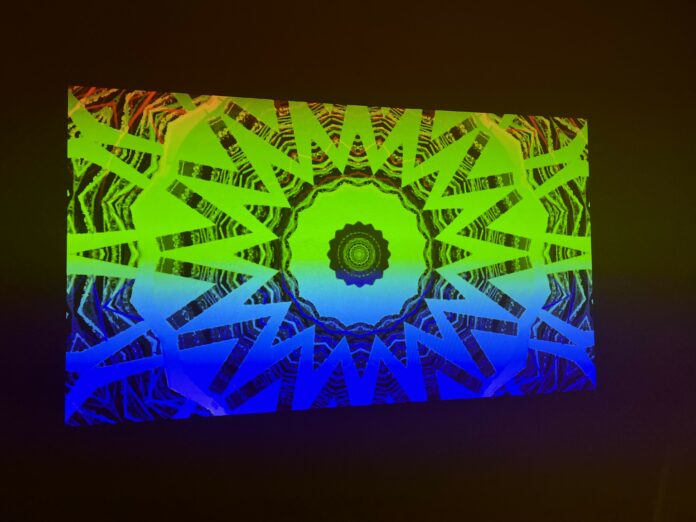The art exhibition “Analog Alchemy: Exploring Nonlinear Aesthetics” opened Oct. 16 and will be viewable until Nov. 17 at the Martin Art Gallery. Analog Alchemy features a series of multimedia pieces created by Michael Filimowicz, Ph.D., who goes by the name Myk Eff, as an artist. Myk Eff is a senior lecturer at the School of Interactive Arts and Technology (SIAT) at Simon Fraser University in Vancouver, Canada.
The exhibit was curated by Jessica Ambler, director of the Martin Art Gallery. She says that she “was incredibly impressed with Myk Eff’s diverse range of interests and scholarly pursuits which include everything from experimental video and creative writing to net art and digital photography.” Ambler also organized the artist talk which took place on Oct. 18.
In addition to going to the exhibition, I attended Myk Eff’s talk, which was enlightening and interesting. During his talk, Myk Eff spoke about his artistic process which includes using VJ Loops, a new form of silent cinema that is produced for electronic music performances and Video Rhythmologies, which combine digital video stills from the VJ loops into large scale canvases. He spoke about his process of creating work which included complex mathematical equations, which he has higher-level mathematicians do for him. Myk Eff focuses on more traditional forms of image synthesis by using tools that emulate the process of analog tools rather than digital. He went on to say that digital tools don’t typically exhibit nonlinear behavior in terms of their output which is why he uses software that emulates analog circuits, because they add in additional distortions which are key to the creation of his work.
The exhibition is a combination of print and digital media. The digital pieces are shown on the white walls of the gallery using projectors. When you first walk into the gallery, the room is darkened, with the main sources of light coming from the three projectors placed around the room.
My favorite piece was “Projector 2: Mandalas,” which moved through a series of geometric configurations of symbols. The piece was reminiscent of kaleidoscopes; the piece was mesmerizing, I could have looked at it for hours.
The print pieces were created using video rhythmologies. A unique part about the creation of these artworks is that they are produced in either 16K or 32K resolution. Digital art is typically too low resolution to be made into large prints, however, the higher resolution allows for this. Ambler said, “The prints are actually digital composites– what the artist calls ‘tapestries’– of stills from the video works in the show.”
Some of the art is very geometric and pattern-focused and then there are pieces that seem more random in nature. The interesting aspect about these pieces, like “Video Rhythmology No. 21: Engereia,” is that they use basic shapes like squares, but within the squares, the colors and shapes are more free-flowing and abstract, which Sasha Dzhanibekova ‘27 remarked on. Dzhanibekova said that the piece “reminds me of thermal imaging and how hotter things are a different color than cooler things.”
One piece that displayed the geometric nature of the exhibit was “Video Rhythmology No 31: Method.” This piece is mono-chromatic purple which helps to focus the viewers’ attention on the shapes of the piece, rather than the display of colors, which can be seen in “Video Rhythmology No 29: Pastel Light District.” Maya Schlegel ‘27 noted that she “really liked the colors, it’s very put together and visually pleasing to look at.” Caitlyn Montgomery ‘27 found the work “aesthetically pleasing.” Emily Nally ‘27 said that it was “something I’ve never seen before.”
The final part of the exhibition and my personal favorite was “Ylem.” In the gallery was a black tent and inside the tent was “Ylem.” The darkness of the tent allows you to fully appreciate the beauty of the piece as you sit back on beanbag chairs and watch “Ylem” appear before your eyes. The tent helps the viewer not only focus on the VJ Loops playing but also block out the light and movement from the projectors in the Gallery. In combination with the chairs, which allow the viewer to sink into their seat the way that they sink into the Loops, the tent works to capture the attention of the viewer and make seeing “Ylem” a truly artistic experience.






















